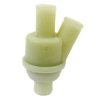NickPalmer
Member
- Posts
- 40
- Location
- birmingham
Hi hope someone can help
I have a 2004 freelander.
The car has been losing coolant from bubbling out of the expansion bottle as you can see where it has tricked down the outside of the bottle, I have also witnessed the coolant rising to the top of the bottle / cap. The rac advised to change the thermostat, which I have done and also the cap, but but still bubbles over, in have checked for air locks etc.
The car had the upgraded head gasket 4 months ago.
The pipes to seem to get quite hot and hard and the radiator doesn't get hot for quite a time, therefore the thermostat doesn't open? I did test the thermostat and it opened when I put hot water in from the single bottom inlet but not the other two, is this correct?
It's losing basically the expansion bottle worth of coolant over a 40 mile journey
Any suggestions would be much appreciated
Thanks
Nick
I have a 2004 freelander.
The car has been losing coolant from bubbling out of the expansion bottle as you can see where it has tricked down the outside of the bottle, I have also witnessed the coolant rising to the top of the bottle / cap. The rac advised to change the thermostat, which I have done and also the cap, but but still bubbles over, in have checked for air locks etc.
The car had the upgraded head gasket 4 months ago.
The pipes to seem to get quite hot and hard and the radiator doesn't get hot for quite a time, therefore the thermostat doesn't open? I did test the thermostat and it opened when I put hot water in from the single bottom inlet but not the other two, is this correct?
It's losing basically the expansion bottle worth of coolant over a 40 mile journey
Any suggestions would be much appreciated
Thanks
Nick

